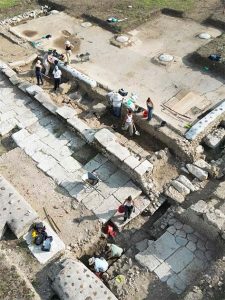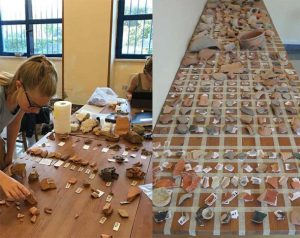A Shadowy Roman Village Escaped the Decline of Empire in the Third Century: Interamna

Two thousand years ago, the ancient Roman settlement of Interamna Lirenas in central Italy’s Lazio region was a typical remote Empire town. It was believed to have suffered the same fate as so many obscure Roman settlements during the politically and economically stressful second and third centuries, declining gradually at first and then more rapidly before falling into oblivion by the year 400.
But a new study from archaeologists at the University of Cambridge, which has just been published in the edited anthology Roman Urbanism in Italy, reveals a far more complex history for this small and not-particularly-noteworthy Roman village. It seems that Interamna Lirenas was surprisingly resilient in the face of the Empire’s third-century decline, adapting and adjusting and maintaining a certain amount of success and prosperity despite its relatively remote location. The site continued to be occupied long after what might have been expected, even surviving the fall of the Roman Empire to some extent.
How the Rise and Fall of the Roman Empire Shifted Populations
The Devaluation of Rome: Roman Inflation and the Demise of the Empire
This discovery is the culmination of a long-term archaeological analysis of the now deserted Interamna Lirenas site, completed by a team of Cambridge archaeologists who began their work more than a decade ago. Their goal was to track an average Roman Empire-era town’s history of occupation and development over the course of multiple centuries, to see how it was impacted by macro trends affecting the ancient Roman world.
“What makes Interamna special is that we think it may not have been that special at all,” Cambridge researcher Alessandro Launaro, who wrote the section about Interamna Lirenas published in Roman Urbanism in Italy, told Newsweek. “It was of average size and occupied a middling position in the settlement hierarchy—it is therefore likely to be more representative of a large number of towns which dotted Roman Italy and the empire at large.”
Assuming the village was representative, what it reveals about how the decline of the Roman Empire impacted—or didn’t impact—its people is eye-opening to say the least.

Gorgon antefix (likely 3rd to 2nd century BC), found in a dump of material within the theatre following its abandonment. The antefix probably belonged to an earlier nearby building. (Alessandro Launaro)
Archaeological Survey of Interamna Lirenas
In their comprehensive archaeological study of Interamna Lirenas, which took a stunning 13 years to complete, Launaro and his colleagues carried out a series of magnetic surveys and ground-penetrating radar sweeps to create a detailed map of the ancient, and mostly buried, town’s entire layout. They discovered that this supposedly sleepy backwater actually had an impressive history of constructing and maintaining elaborate or highly-functional structures that endured throughout time.
The architectural successes of the Interamna Lirenas builders included a sprawling roofed theater, several open market areas, multiple warehouses for storage, a temple, several Roman bath complexes and an assortment of port-related structures and facilities. Excavations and analysis revealed these structures had been constructed and used over an extended period of time (Interamna Lirenas’ reign as a bustling port city lasted from the late first century BC through the third century AD, for example).
Seeking more information about the village’s people and culture, the archaeologists launched fresh, targeted excavations based on the results their mapping activities, searching in neglected areas they now knew contained interesting ruins and artifacts. They uncovered a treasure trove of pottery fragments during these digs, which were key in revealing that the settlement had thrived for far longer than experts had previously believed.

Drone view of the excavation of two footpaths lining the street separating the basilica (top) from the theatre (bottom) at Interamna Lirenas. (Alessandro Launaro)
Tens of thousands of pottery pieces recovered from different sites and in different excavation layers showed that the town had only begun to lose population and territory in the latter part of the third century AD, and not in the first century AD as Canadian archaeologists had concluded after carrying out more limited excavations in the 1980s. As many as 2,000 people may have lived in Interamna Lirenas when it reached its peak of population, a number which probably did not decrease for the majority of the third century.
“Interamna Lirenas had long been assumed to have experienced a rather early decline, turning into a sleepy, backwater village—a town only in name—already by the end of the first century BC,” Launaro explained. “But what we revealed is the complex, monumental and articulate plan of a town, which peaked from the second century BC to well into the third century AD and continued to be occupied—although to an increasingly smaller extent—even afterwards, until its complete abandonment in the later sixth century AD.”
From the perspective of the traditional historical view, all of this is rather stunning and unexpected. In the third century, the Roman Empire, and Italy in particular, experienced a perfect storm of difficulties, including repeated invasions, civil strife, plagues, economic instability and a general malaise and loss of confidence in the future. At various times, the collapse of the Empire seemed imminent. During the second century some of these problems were beginning to be experienced, in somewhat less severe form.Top of Form
“Italy is often understood to have experienced a precocious decline within the empire—political, economic and even demographic—already in the second century AD, losing its prominence to the advantage of the provinces,” Launaro said. “We believe Interamna to have in fact adapted to those new conditions, building on a solid network of local political, social and economic relationships, whose existence preceded, continued and, to a point, outlasted the rise and fall of the Roman Empire.”
Launaro is quick to emphasize that there is nothing unique about Interamna Lirenas. It was a typical Roman Italian settlement in every way. “As this town was unlikely to be special, we think this may give us a better view of how other communities in Italy—and maybe across the empire later on, more generally—may have adapted and even thrived in the face of new and challenging conditions,” he stated.

Archaeologists processing pottery excavated at Interamna Lirenas. (Alessandro Launaro)
In the Face of Inexorable Decline, Interamna Lirenas Remained Strong
Based on a casual examination, in the past there was no reason to think of Interamna Lirenas as anything other than a failed village with an uninteresting history. “We started with a site so unpromising that no one had ever tried to excavate it—that’s very rare in Italy,” Launaro explained in a University of Cambridge press release.
“There was nothing on the surface, no visible evidence of buildings, just bits of broken pottery,” he stressed. “But what we discovered wasn’t a backwater, far from it. We found a thriving town adapting to every challenge thrown at it for 900 years.” Rather than going extinct in the third century AD, when times were tough, the residents of this remote village in Southern Lazio rose to the challenge and kept their settlement strong and vibrant.
Even with the forces of chaos threatening, in out-of-the-way Interamna Lirenas people continued to come to the village to attend plays and musical performances at its spectacular roofed theater, which was constructed from imported marble and would have been big enough to seat 1,500 patrons of the arts.
“The fact that this town went for a roofed theater, such a refined building, does not fit with a backwater in decline. This theater was a major status symbol. It displayed the town’s wealth, power and ambition,” Launaro stated.
The Roman Empire: A Story of Power, Glory, and Tragedy
Barbarians versus Romans: Violence and Urban Life in Late Antiquity
Interamna Lirenas remained a densely populated settlement for centuries, with 80 percent of its residents living in small houses while the town’s elite occupied approximately two dozen large homes or Roman villas. It is likely the social cohesion and sense of shared purpose of the town’s citizens was strong, helping them build thriving local micro-economies that were insulated from larger trends threatening the long-term viability of the Roman Empire. Its port remained active and busy, bringing traders and tourists and ensuring the continuation of Interamna Lirenas’ import-export sector and keeping at least some investment funds flowing in from the outside.
“We believe that this community thrived as a regional trade hub throughout its history and was able to play this role and benefit from it even when conditions across the empire were probably less favorable to Italy and the Italians than they had been before,” Launaro summarized.
From the perspective of history, it is clear that the decline and eventual collapse of the Roman Empire was inevitable. But the citizens who lived through its second and third centuries couldn’t have anticipated that, so the tough times spurred resilience and determination rather than surrender. This guaranteed that Rome would last a bit longer than might otherwise have been possible, continuing to thrive in many locations even when the odds were against it.